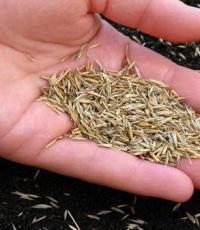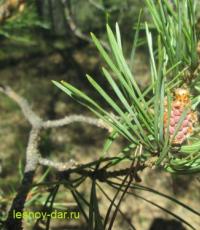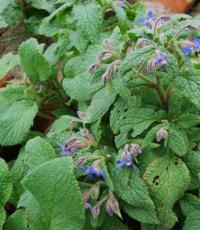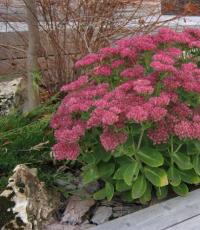Which coniferous tree blooms with red flowers. How conifers bloom
Hello dear reader!
No, of course, everyone knows that the pine tree does not bloom, and cannot bloom. She, like others, does not have such a specialized reproductive organ as a flower.
But, looking at the pine branches in May, it's hard not to exclaim - how beautifully the pine blossoms!
Male cone (microstrobilus) at the top of a pine shoot
Naturally, these are not flowers. On the tops of many elongated shoots of adult pines at this time, formations called microstrobils appear. Or male cones, which, however, is not entirely accurate.
Microstrobili consist of microsporophylls, sitting on an axis in a spiral. It is in them that male spores (microspores) of pine develop, and here they germinate, forming male gametophytes.
Indeed, in all seed plants, unlike ferns, male and female gametophytes develop not outside, but inside the sporangium.
In this peculiar “flower” on the tops of pine branches, its pollen grains grow. Each is equipped with two huge, relative to size, air sacs.
Pollen grains are very light, they float on the surface of the water. Why is there water - studies have shown that air currents carry pine pollen hundreds of meters up and thousands of kilometers away from the forests where it was formed. In air samples taken over the ocean, two thousand kilometers from land, the content of pine pollen is very high!
The appearance of the "male cones" of the pine changes as they develop, becomes more colorful. Microsporophylls turn yellow or pink.

This is how pine blossoms (pine microstrobils with pollen)
Next to the microstrobiles (“male cones”), not at the very top of the shoot, but a little to the side, real cones develop. They are also female strobili, or megastrobils. Here, under the covering scales, in megasporophylls, female pine megaspores are formed. Here they germinate, forming female gametophytes - ovules.

And this is a female pine cone (megastrobil). Pollinated a year ago
Neighborhood, however, is not required. Two cones can grow near the top of the shoot. Or maybe none.

Pollinated cones are clogged with resin, and for almost two years the sacrament of the birth and development of seeds takes place in them.
But in this photo - developing young pine shoots. The same pine buds that are harvested for medicinal purposes.

Young shoots of pine ("pine buds"). They have nothing to do with the "flowering" of the pine
This is how the pine blossoms. "Blossoms", of course, in a figurative sense. But also very beautiful! In May, they dust, “bloom”, not only, but also other conifers - larch, Siberian cedar.
This article has a sequel. You can get to know him.
Scotch pine
Pine is a tree that, under the best growth conditions, reaches a height of 30-40 meters (sometimes up to 45) and more than a meter in diameter. The crown is transparent with a rounded or flat top, raised high. Branching is whorled, but on trunks and thick branches such whorliness is obscured by the development of individual branches and overgrowth of traces of dead and fallen branches. Nevertheless, up to 30-40 years, the age of a tree can be determined quite accurately from well-marked whorls, assuming that one whorl is formed annually.
Burn with bright flames
Pines old, mighty,
Dressed up coniferous nets
And covered with gold-woven.
S. Yesenin.
Warning: getimagesize(/images/pages/2pg1_67_67..php on line 128
Warning: getimagesize(/images/pages/3pg1_67_67..php on line 128
Protea nana

Protea nana
Protea is another unusual discovery, for which the brave seekers of innovations and curiosities in the field of floristry are to be thanked. This exotic flower, which is native to South Africa, is not yet a frequent visitor to our country. However, florists have already noticed it and are using it more and more actively and boldly in their compositions. The Internet writes about him "in Yakutia, a pine blossoms once every 100 years."

Proteus (Protea) is a genus of plants in the Proteaceae family. The type species of the genus is Proteus artichoke ( Protea cynaroides)
Different types of the same flower
Of all the species of this plant, the artichoke protea has become the most famous. It is the national symbol of the Republic of South Africa. In addition, its large flower with a large inflorescence reaching 30 cm in diameter and bright pink petals can also be seen at festivals in Europe and the USA.
However, there are about 400 other types of protea in the world. Some of them look like bright sea urchins, others look like outlandish fruits, others look like unusual stars. Whichever one you choose, be sure that this flower will surely surprise and impress your loved ones.
By the way, even flowers of the same species differ in appearance, shape and size of the inflorescence. So we can say with confidence: just as there are no two identical snowflakes, you will not find two absolutely similar proteas.

Until the "anonymous" wrote that it was a protea, I myself thought that it was a pine tree, and even once every hundred years. Wow, how!
It is believed that the pine does not bloom and cannot bloom. She does not have such a reproductive organ as a flower. In May, on the tops of the elongated shoots of adult pines, formations called microstrobili appear. They are made up of microsporophylls. It is in them that male pine spores develop. In this so-called "flower", its pollen grains grow on the tops of pine branches. In May, DUST, "bloom", not only pine, but also other conifers - spruce, larch, fir, Siberian cedar.
Grevillea from the same Proteaceae family
This is larch. Larch was considered the tree of the World. In nature, "blooms" much more beautiful.
Larch (Larix) is a genus of coniferous summer-green trees of the Pine family (Pinaceae). The Latin name of this tree "Larix" was introduced into scientific literature at the beginning of the 16th century, but so far its origin has not been fully elucidated. It is assumed that it is translated from the Gaulish language as "resin", but, according to other experts, this word comes from the Latin "Laridum", which means "fat", which also emphasizes the presence of a large amount of resin in larch.
This is the only genus of conifers in which the needles fall for the winter. The ancestors of larch were evergreen trees, and the ability to drop foliage in autumn arose as a result of adaptation to a harsh climate (with frosts down to -60 ° C).
Like its ancestors - deciduous trees - in the fall, before shedding its leaves - needles, Larch dresses up in gold.

The tree belongs to monoecious plants - heterosexual flowers are located close to each other, on the same branch. Male "inflorescences" are located on leafless shortened shoots, mainly on the underside of the branches and abundantly secrete pollen carried by the wind.
Women's - oblong, red, pink, green.
After pollination, the female spikelets transform into a bud, from which a cone subsequently develops.
The Nenets consider Larch a sacred tree - a symbol of Light and Goodness. On certain days, they put on deer skins and antlers - as a sign of worship. Shamans drive away evil spirits with the help of the burning Larch smoke, and amulets are made from wood.
The Yakuts brought gifts to the forest spirits in the grove and hung them on the branches.
And the Slavs - pagans in Russia believed that if trouble happened, you need to “talk” with Larch - she will calm ...
The Mansi people have a legend that God created the oceans, seas, plants, animals ... And the time has come for him to create a person, and for the material He chose strong Larch. And now He carved figures of people from wood and had to revive them, but evil spirits stole the wooden figures and put clay blanks in their place. God did not know this and revived the clay figures. Since clay is a fragile material, people turned out to be weak and weak ...
In the Yakut myths there is a mention of the iron larch of the world of the dead, which grew with its roots up.
There is a belief in Altai that those who travel through the mountain for the first time or go on a matchmaking visit are supposed to tie white ribbons on a birch or a young Larch for a successful outcome of the trip.
A Larch amulet or just a sprig of it will help protect you from witchcraft or protect you from the evil eye.
The smoke of burning larch is able to drive away evil spirits. The tree is used for protection. There is evidence that shamans used larch to enter a trance and induce visions.
The legend of the wise Cedar and the beautiful Larch
Somehow they lived near Cedar and Larch. Everyone admired and admired Larch - both people and animals and birds. And she became proud: they say, I am the sweetest in the world! And she boasted of her beauty until hungry cubs came to her. They asked to be fed and saved from hunger. But Larch could not do this, and Cedar silently gave them his nuts, which saved the cubs from starvation. Larch realized that not only beauty is important in life. She felt ashamed and from shame her needles turned yellow and crumbled. Since then, she sheds her needles every year, losing her former beauty for a while ...
The use of Larch in medicine and the national economy
Larch is a protector. In medicine (and in magic) it is known as a soothing tree. If a person is not left with fears, doubts, unreasonable anxiety, contact with Larch will bring him great relief. It heals severe nervous disorders, especially those accompanied by bouts of melancholy and depression. The energy of Larch helps to remove self-doubt, underestimation of one's abilities, helps a person to open his unused opportunities. Larch will exclude from the human repertoire the phrase: "I can never ...".
In addition, infusions of pine needles are used as a medicine, which have a high content of ascorbic acid, which has a beneficial effect on the body, preventing the development of scurvy, strengthening teeth and gums from abscesses.
The essential oil of Larch, obtained from wood, is called turpentine and is used as an external remedy for rheumatism, gout, neuralgia, lumbago.
Waste - cuttings, branches, wood chips, greens - is currently used for the production, including vitamin flour for farm animals and poultry. From the technical greenery of Larch, scientists have learned how to obtain medicinal preparations useful in atherosclerosis, increased permeability and fragility of capillaries, and diseases of the central nervous system.
Resin scraped from trees with damaged bark is used in folk medicine for headaches: it is placed in pots and placed overnight in a hot oven, after which it is cooled and used to rub the temples. The resin is also used for chewing in order to clean the teeth and strengthen the gums.
The use of Larch wood sawdust as roughage in the diet of cattle not only does not have a damaging effect on the digestive tract of animals, but, on the contrary, reduces the incidence of parakeratosis and liver abscess in calves.
Scientists believe that the possibilities of the "taiga queen" are far from being exhausted. It is only necessary to carefully and carefully treat this most valuable tree.


It is believed that larch owes its extreme resistance to frost and other hardships to special substances contained in wood - dihydroquercetin and arabino-galactan. The first in wood up to 1.5%, it is successfully used in formulations of medicines, ointments and dietary supplements. Arabino-galactan is its starch-like substance in larch wood up to 35%. If the wood is boiled for a long time, for 4 hours, then thanks to this substance, a jelly-like nutrient mass is obtained. Inhabitants of Eastern Siberia, Evenks at critical moments thus received an additional food product.
According to the scale of light-loving tree species, larch is considered the most light-loving species.
Coniferous trees mainly bloom in spring, and cedar in Siberia and Lebanon begins to bloom in autumn. The flowers of coniferous trees are unusual, more like pot-bellied barrels, in the form of cones. Siberian and Lebanese cedar are different, the cones are different in color and shape.



Conifers in our understanding do not bloom, since they are not flowering plants, but gymnosperms. However, flowering is still not alien to them, only coniferous flowers do not look like flowers, but like cones or spikelets, which usually do not smell. Since conifers are wind-pollinated, they usually bloom before the leaves on deciduous trees have blossomed - otherwise the foliage could interfere with the transfer of pollen by wind. This is how the pine blossoms:

So - spruce:

so - cedar:

So - thuja:

And so - juniper:

Coniferous trees in the generally accepted understanding of flowering do not have such an attractive appearance as, for example, blooming cherry or apple flowers. Coniferous flowers are similar in appearance to yellow spikelets (male inflorescences) or pinkish cones (female inflorescences). They usually bloom in May before the appearance of young leaves on deciduous trees. Flowers usually do not smell. Pollen from inflorescences is carried by the wind over long distances and frightens ignorant people who see a threat to the health of others by observing yellow puddles and unusual dust on the roadsides.
Coniferous trees do not have flowers, but when spring comes, they begin to bloom with the help of cones.
Although these trees do not have flowers, they bloom just as beautifully as trees and plants that have flowers. apart from that, coniferous trees have a very good smell. When you walk not far from these trees, you immediately feel the smell of spring.





Not every person has not only seen, but generally knows that coniferous trees bloom with beautiful flowers.
This is how the pine blossoms:

And here are the flowers of the spruce:

Here is a cedar flower:

And here are the juniper flowers:

Flowers near coniferous trees very peculiar, not like other colors that we are used to seeing. But, like all flowers, they are beautiful. Of course, amateur photographers also appreciate them and capture them in their photographs. thanks to them, we can also see how various coniferous trees bloom, which we may not have seen before.
Conifers include:
Colors cedar a:

cypress flowers:

fir flowers:

juniper flowers(found only this photo):

larch flowers(otherwise called taiga rose):


spruce flowers:

pine flowers:

Japanese pine flowers:

sequoia flowers:

I will show in the pictures how different coniferous plants bloom. That's very beautiful.
This is how the pine blossoms:

Although the color often has a reddish tint:
Spruce usually blooms like this.
It is well known that pine is a coniferous tree, and all conifers are gymnosperms that do not bloom in the usual sense of the word. But, answering the question “does the pine blossom”, from a scientific point of view, one should say “yes”. It's just that her flowers are not the same as those of an apple or cherry tree.
General information about flowering conifers
The flowers of all coniferous plants resemble cones or spikelets. Their appearance is very uniform (at least for those conifers that grow in Russia). Pine, fir, larch, etc. representatives of the vegetable kingdom are pollinated by the wind. Therefore, their flowers do not exude any aroma and have an extremely inconspicuous appearance.









When do pine and other conifers bloom? The flowering period falls on early spring, when leaves have not yet appeared on deciduous trees. At this time, there are no barriers to the spread of pollen.

pine blossom
Consider when the common pine blooms in our country. Its flowering occurs in May - June. The tree produces flower arrows at the end of April, but flowers bloom only when the temperature is above 20 ° C.

In other words, the beginning of flowering depends on temperature indicators. If spring has come late and the weather is cold outside, then the inflorescences on the pine tree can be seen for a whole month. Usually, it's June.

Types of pines
Today, approximately 124 species of these beautiful conifers are known to exist. But all pines bloom in the same way. Let's analyze the most popular varieties of this conifer:









Scotch pine
Inflorescences appear in May-June. At the same time, young needles form in the plant. The color of male flowers is bright yellow, female - pinkish. Flowers are placed at the tips of branches, so nothing interferes with their pollination.

cedar pine
The beginning of flowering coincides with the beginning of flowering of the previous species. In general, the flowering of these two types of conifers is similar. The difference is the color scheme of the scales. It should also be remembered that cedar pine and cedar are two different crops.

Weymouth pine
This tree prefers mountainous terrain. It blooms from mid-spring to early May. Cylindrical cones, similar to spruce, but much larger. There are many varieties of Weymouth pine, differing in needle structure, cones, flowers and distribution area.

Features of flowering of other conifers
Cedar
It is a massive, tall tree with a pyramidal or umbrella-shaped crown. The lifetime is approximately 3,000 years. The flowering period is in autumn.

Both male and female flowers are found on the same plant. Male flowers have the form of single barrel-shaped cones surrounded by needles. The size of female cones is slightly larger. Their length can reach 10 cm, and their width - 6 cm. Most often they form a bundle.

Spruce
Spruce flowering is the brightest among conifers. But it begins to bloom only at the age of 25 years. As you can see in the photo, the female flowers are represented by red-green cones with thin scales resembling flower petals.









An ovule is located on each scale. Male flowers are collected in elongated catkins. Their color is red or green-yellow. Location - side branches. The tree blooms in late spring. Flowering time is approximately seven days.

thuja
This evergreen coniferous plant, male and female flowers also differ in color, shape and location. The female flowers of thuja resemble buds in their shape. Their color is yellowish-green, the location is the upper branches.

Male flowers are collected in rounded inflorescences, located at the bottom of the tree, the color is brown-yellow. The flowering time of the conifer is April, the duration is only 2 - 3 days.

The laying of flower buds occurs a year before the flowers bloom. In order for the thuja to bloom, it needs good lighting. As a result, single plants bloom better than group ones.

Juniper
Juniper in Russia is quite common. It can be found both in the Caucasus and in Siberia. It comes in both shrub and tree forms.
Male flowers are solitary, yellow in color and elongated. The female flowers are green in color and form inflorescences.

This shrub is photophilous and unpretentious to the ground. Blooms from May to June. The flowering period is 7-8 days.

Coniferous trees and shrubs perfectly purify the air. Therefore, although they will not please you with abundant flowers, they should be grown on the site.

Photo of a flowering pine tree











































